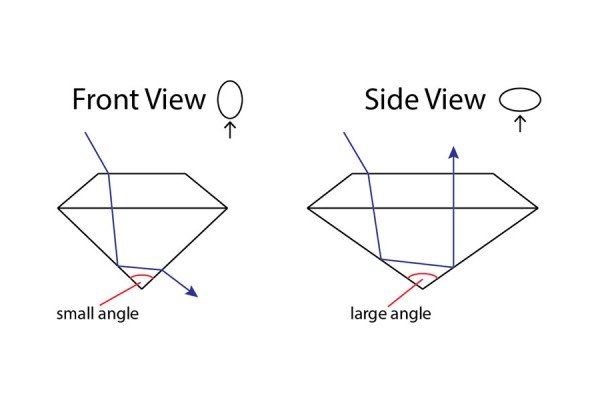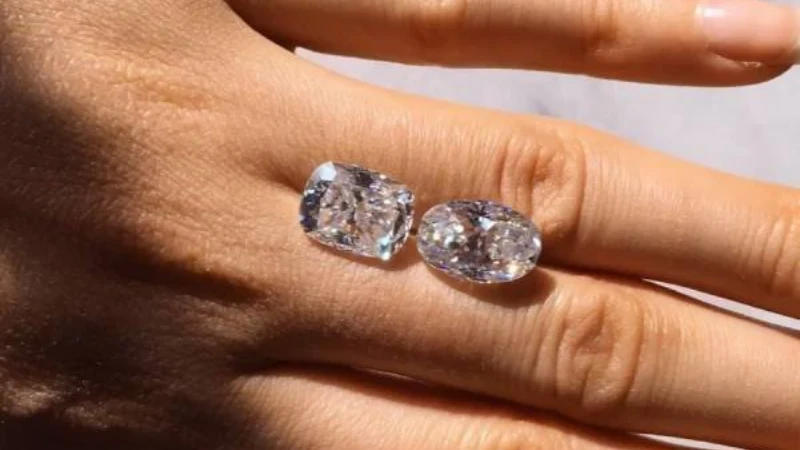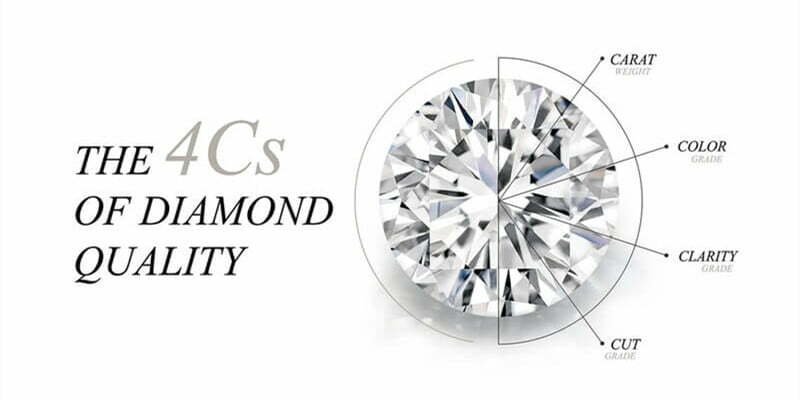brilliant cut
Brilliant cut moissanite gemstones reflect the most light, so sparkle the most. Light enters the top of the moissanite loose stone, reflects several times (from the top facet), and returns through the top of the moissanite gemstone. This is the most efficient way of light propagation, and it produces a lot of light return while showing a well-defined top facet. When you look down at the oval bright moissanite, you see all the light radiating out from the center of the moissanite gem (see image below).

Crushed Ice Cut
In crushed ice moissanite, the light that enters the moissanite gem from the top of it is usually reflected throughout the interior of the moissanite gem. Sometimes it reflects three times or more inside the moissanite gem, and sometimes it bounces off the moissanite gem itself instead of reflecting off the top of the moissanite gemstone. The reason for this is that the crushed ice moissanite gem itself has many facets, and each moissanite gem facet has a different angle. Not as effective as brilliant at reflecting light, as it reflects light in many different directions. It’s also important to note that the more times light is reflected inside the moissanite gem, the higher the chance it has to leave the moissanite gem itself, which means less light is reflected from the moissanite gem. This irregular reflection of light causes moissanite gemstones to look like crushed ice. Below is a comparison between oval brilliant moissanite (left) and oval crushed ice moissanite (right).

You can see that the facets of brilliant moissanite are clearly outlined, while the facets of crushed ice look all broken and somewhat hazy. In addition, the center of the crushed ice has a horizontal black band running through it. This is known as the bow-tie effect and is more characteristic of elongated gemstones such as ovals, pears, marquises, and elongated cushions. Bow ties are where more light leaks are concentrated.
If crushed ice rocks look so inferior, what’s the appeal?
It comes down to personal preference. Some people don’t like the shattered look of bright stone and prefer the shattered look of crushed ice. Some people don’t want too much spark and fire, crushed ice will reduce both. Another reason is because of the way most oval diamonds are cut to give them a crushed ice appearance. In the diamond world, people usually don’t use the word crushed ice when describing ellipses. Brilliant cut oval diamonds already look like crushed ice. In short, crushed ice oval moissanite is closer to a brilliant oval diamond, which is the most common type of oval diamond.
Why a bow tie?
Unlike round moissanite gemstones, ovals have long and short sides. The body facets all converge to a point at the base of the stone, so facets that cross the moissanite gemstone horizontally are shorter than facets that cross the stone vertically. Therefore, the shorter facets make a smaller angle at the bottom, while the longer facets make a larger angle. Essentially, a stone can be like a deep cut stone or a shallow cut stone.
As seen from the front, the small angle at the base causes light to leak through the moissanite gem. This is exactly why the bow-tie effect occurs. The black bow tie seen through the top of the stone is the steepest facet of the main body of the moissanite gem. Longer facets along the length of the moissanite gem can better reflect light through the crown of the moissanite gem. However, if the moissanite gemstone is too long or too shallow, light leakage can still occur.
When cutting an oval, there is a fine balance between cutting too deep to form a bow, and cutting too shallow, which can cause light leakage throughout the stone. Moissanite gemstones have a higher index of refraction than diamonds, making it easier to avoid bow ties. Moissanite’s high refractive index also makes elliptical brights reflect light in a similar way to round brights, ie. Clear, well-defined facets and plenty of fire and brilliance, while oval diamonds tend to have the appearance of crushed ice, as the lower refractive index allows light to take a less-than-ideal path with more reflections. As a result, oval diamonds rarely achieve an in-focus pavilion, so the crushed ice appearance is somewhat standard for oval diamonds.
The image below shows what happens to light when passing through a stone with a higher index of refraction (left) versus a stone with a lower index of refraction (right).

Although incident light strikes both gemstones at the same angle, the gemstone with the higher index of refraction bends the light slightly, as indicated by the large angle of refraction. Small differences in angle can determine whether light is reflected back to the viewer or forgotten through the bottom of the stone.
Both brilliant and crushed ice moissanite gemstones are beautiful cuts. Many people think that brilliants are better at everything: fire, brightness, clarity, and even color (better light returns make the stone appear whiter). So when it comes to pure gem performance, Brilliant gets a nod.
However, moissanite is inevitably on par with diamond, although it really shouldn’t be. Moissanite is its own unique gemstone with its own unique properties. But more often, I get asked the question, “Which cut looks more like a diamond?” I must admit this is one of the hardest questions to answer. Honestly, an ideally cut oval diamond will outshine crushed ice moissanite at all times, but a mediocre diamond probably won’t. However, brilliant-cut moissanite gemstones can exceed the light properties of the same ideal-cut diamond. What I really want to say is that moissanite is being accepted by more and more people now(is moissanite worth buying?. Learn more about Moissanite.




